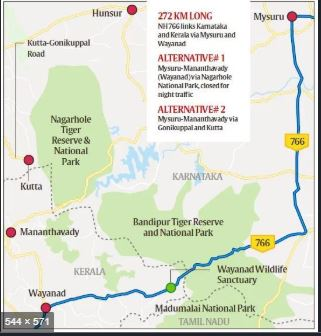Table of Contents
Context: The forest department has served notices to protesting members of 52 Jenukuruba families in the Atturukolli reserve forest of Nagaragole tiger reserve in Kodagu, who have been demanding forest land rights.
Nagarhole National Park
Nagarhole National Park gets its name from the Kannada words “Naga” and “Hole,” which respectively indicate snakes and streams. This park was established in 1955 as a wildlife refuge and was given national park protection in 1988. The following article will educate you on Nagarhole National Park, a crucial subject for the UPSC Exam.

| About Nagarhole National Park | |
| Located | Western Ghats in Karnataka |
| Also Known | Rajiv Gandhi National Park |
| Establishment |
|
| Boundary Sharing | Southern boundary: Wayanad Wildlife Sanctuary (Kerala)
Southeastern: Bandipur Tiger Reserve (Karnataka) |
| Rivers | Nagarahole River, Kabini River (also forms a boundary between Nagarahole and Bandipur) |
Nagarhole National Park History
In the Karnataka regions of Kodagu and Mysore is Nagarhole National Park, also known as Rajiv Gandhi National Park. The Nilgiri Biosphere Reserve, the first biosphere reserve created in 1986, includes this national park. To the northwest of Bandipur National Park is where the park is situated. The size of Nagarhole National Park is approximately 643 square kilometers (core). The Bandipur National Park and the Nagarhole National Park are divided by a barrier on the Kabini River and its reservoir.
Nagarahole National Park was incorporated into the “Mysore Elephant Reserve” in 2000 and included under “Project Elephant” as a result of its sizeable elephant population. The national park now spans 643.392 square kilometres after an addition of 71.84 square kilometres in 2003.
In a typical year, the Kabini backwaters’ fertile banks draw between 600 and 800 elephants during the height of summer, making it the biggest gathering of Asian elephants. Before merging with the Kabini River, the small river Nagarhole flows through the habitat. The largest protected territory in Southern India (about 2183 sq. km) is Nagarhole National Park, which is joined to the neighbouring Bandipur National Park, Mudumalai National Park, and Wayanad Wildlife Sanctuary (Kerala).
Also Read: Eravikulam National Park
Nagarhole National Park Flora
The North Western Ghats’ moist deciduous forests dominate the vegetation in Nagarhole National Park, with teak and rosewood ruling in the southern regions. Rosewood, teak, sandalwood, and silver oak are the primary trees present, all of which are significant commercially. Other tree species that can be found in woodlands include Schleichera trijuga, some ficus species, kadam, cotton tree, and Lagerstroemia microcarpa (crepe myrtle).
Nagarhole National Park Fauna
The Bengal tiger, Indian leopard, dhole, sloth bear, and striped hyena are the main canines and predators in Nagarhole National Park. Chital, sambar deer, barking deer, four-horned antelope, gaur, wild pig, and Indian elephant are among the herbivores. Nagarhole National Park is home to a wide variety of reptiles and more than 250 bird species.
Also Read: Periyar Tiger Reserve
Nagarhole National Park Tiger Status
In 1999, the park was designated as India’s 37th tiger reserve. Tiger density in Nagarhole is believed to be 11.82 per 100 square kilometers, which places it first in the state of Karnataka and third in the nation, behind the Corbett and Kaziranga Tiger Reserves, respectively.
Nagarhole National Park UPSC
The Kabini River, which also serves as a border between Nagarahole and Bandipur National Parks, meets the Nagarahole River as it flows through the park. The Park is a section of the Nilgiri Biosphere Reserve and is located in the Western Ghats. Students can read all the details related to UPSC by visiting the official website of StudyIQ UPSC Online Coaching.


 Aravallis Degradation and Restoration: I...
Aravallis Degradation and Restoration: I...





















